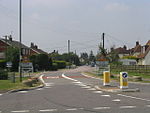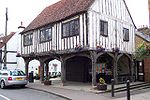Dunton Plotlands

The Dunton Plotlands was an area of small rural plots of land in Dunton Wayletts, southern Essex inhabited from the 1930s to the 1980s.The 'plotlands' consisted of small plots of land sold in the first half of the 20th century to people who built weekend cottages, holiday bungalows or smallholdings there. Many of the people building weekend cottages here would have come out from London. With the outbreak of the Second World War, many weekenders moved out to their plots on a permanent basis, to escape the worst effects of the Blitz. This period saw the Dunton population at its highest. After the Second World War, the new town of Basildon was created, encompassing the plotlands here and in the surrounding areas of Laindon and Pitsea. At the time, 25000 people lived in the whole area, often with unsurfaced roads and limited water supplies.Dunton Plotlands is situated to the west of Laindon and the Langdon Hills, now on the edge of the Basildon district. Today, Dunton Plotlands is part of the Essex Wildlife Trust's Langdon Nature Reserve. The Langdon Visitor Centre and the Haven Plotlands Museum, housed in a converted bungalow, exhibit the natural and social history of the area. The Plotlands is still a wooded area where a small number of cottages, and some of the original grid of grass tracks remain. Visitors can look around a preserved bungalow. Many wildlife events are held throughout the year.
Excerpt from the Wikipedia article Dunton Plotlands (License: CC BY-SA 3.0, Authors, Images).Dunton Plotlands
Third Avenue, Essex
Geographical coordinates (GPS) Address Nearby Places Show on map
Geographical coordinates (GPS)
| Latitude | Longitude |
|---|---|
| N 51.561111111111 ° | E 0.39444444444444 ° |
Address
Third Avenue
Third Avenue
SS16 6EJ Essex, Langdon Hills
England, United Kingdom
Open on Google Maps










